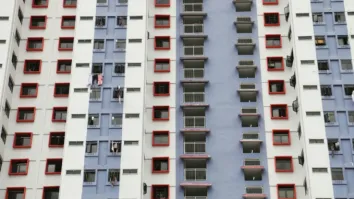
Singapore residential rents slip 0.6% in 2020
That is after two consecutive years of increase.
With Q4 traditionally being a slower quarter due to the confluence of the year-end holiday and festive season effects, leasing volumes of private residential units fell 11.7% QoQ to 23,823. Nevertheless, the number of leasing transactions in Q4/2020 was 15.1% higher than the same period in 2019, the highest since the data was first published in 1999.
According to Savills, this may be attributed to more people returning to Singapore after strict border controls in the early stages of the pandemic were relaxed. Also, with the economy gradually being freed up, permanent residents, long-term pass holders and overseas students began to look for new or replacement accommodation. The pent-up demand for short to mid-term accommodation therefore drove up the leasing numbers.
Here’s more from Savills:
The top five non-landed projects with the highest number of leasing transactions in Q4/2020 were The Sail @ Marina Bay at Marina Boulevard, Marina One Residences at Marina Way, D’Leedon at Leedon Heights, Reflections at Keppel Bay at Keppel Bay View and Queens Peak at Dundee Road. Of these, three of them were located in CCR. While the rental transactions in each of these three developments were mainly for smaller units (one- and two-bedrooms), the rental volume by unit type for D’Leedon was quite balanced in Q4/2020, with a good mix of one-, two- and three-bedroom units. This is likely due to the development being situated near a diverse range of amenities as well as its proximity to renowned educational institutions, making it suitable for diff erent groups of occupants.
In 2020, the total number of rental transactions was 92,506, a decline of 1.5% from the 93,960 in 2019. This was a reversal from the 4.5% YoY increase in 2019. The fall in leasing volume was largely led by the growth in expatriates leaving the country, fewer coming in due to less employment openings and travel restrictions arising from the COVID-19 pandemic. Moreover, it was also reported that during the pandemic, the number of S Pass and Employment Pass holders declined. The leasing volume fell the most in CCR by 3.2% YoY. This was followed by Rest of Central Region (RCR) by 2.3% YoY. On the other hand, rental transactions in Outside Central Region (OCR) grew marginally by 0.5% YoY as new completions in the recent years are mostly situated in this market segment and rents of homes in this area are more affordable. There was also a downgrading effect as salary cuts and reduced rental allowance motivated foreigners to look farther afield for accommodation.
In the past five years, there has been a steady increase in demand for smaller units. While the proportion of leasing transactions rose for both 1- and 2-bedroom units1 , there was a larger growth in the proportion of rental transactions for 1-bedroom units from 16.2% in 2015 to 23.3% in 2020. The proportion of rental transactions for 2-bedroom units grew by a smaller 2.6 ppts to 35.0% in 2020. Consequently, the proportion of leases for bigger units began to decline over the years, particularly for 3-bedroom units where proportion had fallen significantly by 7.9 ppts to 33.3% in 2020. This can be attributed to smaller household sizes and such a trend is expected to continue, as the millennials who work from home may prefer to move out from their multigenerational family homes for privacy.
RENTS
Despite a decline in leasing volume on a QoQ basis, the private residential leasing market largely remained stable in Q4/2020 with the URA rental index for all private residential properties registering a slight uptick of 0.1% QoQ after two consecutive quarters of decline. After falling 1.1% and 0.6% in Q2 and Q3 respectively, the URA rental index for non-landed private residential properties recorded a smaller QoQ decline of 0.1% in Q4. While rents of non-landed homes in RCR and OCR continued to grow for the second consecutive quarter, rising 0.9% QoQ, rents of such properties in CCR fell further in the final quarter of 2020, albeit a slower pace at 1.2% QoQ. This can be attributed to weaker demand in the prime areas as expatriates reined in their rental expenditures due to the uncertain economic and employment situation and may even relocate to less costly options in the city fringe or suburban areas. Landlords, as a result, were more flexible in their rental negotiations and were willing to drop rents marginally to retain or attract tenants.
Despite the marginal increase in rents island-wide in Q4/2020 and limited new completions for the whole of 2020, rents still slipped 0.6% YoY in 2020, reversal after increasing for two consecutive years. The URA rental index for non-landed residential properties fell by 0.5% YoY in 2020, brought about by declines in rents in CCR and RCR of 2.4% and 0.1% respectively. On the other hand, the leasing market in OCR continued to perform well as rents rose by a larger 3.0% in 2020, from the 2.7% increase in 2019.
In a similar pattern to the downward movement in the URA rental index for nonlanded properties in CCR, monthly rents for high-end non-landed private residential projects tracked by Savills also fell 0.7% QoQ to S$4.08 psf in Q4/2020. As such, average monthly high-end rents fell by 2.2% for the whole of 2020. In 2019, there was an increase of 2.9%. The luxury market was more affected by the pandemic as compared to homes in the cityfringe or suburban areas as companies adopted cost-cutting measures such as substituting expatriates with locals or reducing the former’s housing allowance. The latter move led to tenants to seek out low-cost alternatives.
STOCK AND VACANCY
In the final quarter of 2020, 1,249 private housing units obtained their Temporary Occupation Permits (TOPs). Most of this new supply came from Grandeur Park Residences (720 units) and Forest Woods at Lorong Lew Lian (519 units), both located in the OCR. The completion of private residential properties came to 3,433 units for the whole of 2020, less than half of the 7,527 units recorded in 2019. The plunge in new completions was largely due to delays in the construction process arising from COVID-19 restrictions in 1H/2020. Island-wide, the stock of private residential units inched up marginally by 0.7% YoY, or 2,479 units to 376,040 units by Q4/2020. The increase of 0.7% was slightly lower than the 1.0% growth in 2019.
Despite a slower growth in new supply in 2020, the vacant stock grew by a faster pace, by 28.9%, or 5,915 units YoY. This led to a YoY increase of 1.5 ppts in vacancy rate from 5.5% in Q4/2019 to 7.0% in Q4/2020, a reversal from the YoY decline of 0.9 of a ppt in Q4/2019. Across the market segments, the largest YoY growth in vacant stock was in CCR (58.9%), followed by RCR (27.7%) and OCR (10.3%).
OUTLOOK
With many countries now rolling out their vaccination programmes, it is anticipated that the pandemic, which has been already a year-long, can be controlled soon. With some light visible at the end of the tunnel, economic activity and cross border travel can gradually trend back up. Economists have raised their forecasts for Singapore’s growth in 2021 from 5.5% in the December 2020 survey to 5.8% in the most recent survey. The employment outlook is also brighter, with the overall unemployment rate expected to be lowered to 2.9% in 2021. The previous poll had it at 3.0%. The improved outlook for 2021 was led by the containment of the pandemic and the possibility of reopening of borders and better global economic growth. Moreover, the containment of the COVID situation in Singapore, even before the introduction of vaccines, may further boost the confidence of investors and foreigners, accelerating the pace of foreigners returning to Singapore once the situation stabilises.
Additionally, the Monetary Authority of Singapore (MAS) announced, in October 2020, an extension of reduced instalment payments for a period of up to nine months, for individuals with residential property loans. This provided a breather for homeowners and those who have purchased properties for rental purposes may not be that pressured to reduce rents significantly for the mortgage repayments.
Coupled with limited completions in 2021, the rental market is expected to largely stabilise and may even see some improvement in 2021, particularly for the city fringe and suburban areas, as tenants are likely to remain price conscious as they await to see how things pan out in the near term. For 2021, our forecast for non-landed private residential rents will therefore be flat with an upper bound of +2% and a lower band of -1%.



















 Advertise
Advertise





